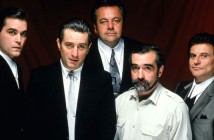
Editor’s Notes: The Editor spliced into Canadian Theatres September 18th including Toronto (Carlton Cinemas). The film also has limited engagements in Ottawa, Kitchener, Hamilton, and Vancouver.
Gruesome. Inspired. Hilarious. These are words that could be used to describe the poster for The Editor, which brilliantly recalls the old Italian horror movie one-sheets; the nude corpse of woman draped lifelessly over a Steenbeck film editing station. Sadly, none of those words can be applied to the film itself, a movie so high concept it climaxed in its advertising campaign.
Mostly you’re just waiting for the next kill, none of which are as inspired as those in the films of the 1970s that inspired them.
A Canadian pastiche of Italian giallo horror (those hyper-gory slasher movies made famous by the likes of Dario Argento and Mario Bava), The Editor stars co-writer/director Adam Brooks as Rey Ciso, a former top Italian film editor brought low after his biggest cutting job saw him cutting off his own fingers. Now working on a junky giallo and disrespected by cast and crew, he finds himself in big trouble when his enemies and critics start coming to bloody ends.

On his trail is Detective Porfiry (the film’s other director, Matthew Kennedy), a hard-boiled yet unseasoned cop with a look charmingly stolen from Donald Sutherland in Don’t Look Now. His wife was working on the same film before she was blinded by the sight of the first victim, in a cute nod to Lucio Fulci’s The Beyond. Porfiry’s investigations all seem to lead to Rey being damaged goods, and the only viable suspect, despite the movie’s main star having a car trunk full of chainsaws.
The whodunit plays second fiddle to a series of largely superfluous scenes meant to send up elements of the movie business; secretly gay leading men, producers taking advantage of beautiful would-be actresses, underpaid and unappreciated behind-the-scenes crew. Some of these ideas are clever, such as a gag about video replacing film, or a Fellini-esque filmmaker’s gargantuan ego project. But these moments are fleeting. Mostly you’re just waiting for the next kill, none of which are as inspired as those in the films of the 1970s that inspired them.
To fill in the gaps in the gags, The Editor opts to take shots at that easiest of targets, old-timey chauvinism.
Borrowing from the likes of pastiche TV shows like Danger 5 and Garth Marenghi’s Darkplace, there’s plenty of humour derived from bad Italian accents and awkwardly imperfect lipsyncing – it’s the sort of joke that amuses for a while before becoming tiresome; there’s a reason those shows were only 20-minutes long. To fill in the gaps in the gags, The Editor opts to take shots at that easiest of targets, old-timey chauvinism. Scene after scene features women needlessly taking their clothes off (yes, that’s the joke), while a running gag has the detective slapping every woman he meets, and enjoying some aggressively demeaning sex. Wherever the line between finding the idea of misogyny laughable, and relishing indulging in it is, The Editor has spliced right over it. By the time you reach the final act rape scene, you begin to wonder if any of this was ever meant to be funny to begin with.
Which is not to say there aren’t moments to enjoy. Kennedy’s delivery is great, particularly when insisting on calling a priest “wizard”. Udo Kier shows up for a spell and thoroughly dismantles the scenery with his incisors. Paz de la Huerta is suitably (and characteristically) crazed as Rey’s estranged wife. Some of the dialogue nails the genre’s most clichéd aspects: “You’re a man who’s seen darkness and returned to tell the tale.” The finest gag, meanwhile, is the title of one of movies within the movie: The Cat with the Velvet Blade, a title so Argento it’s easy to imagine Argento being angry he didn’t get to use it for real.
But all in all none of it works well. The gore rarely surprises and never scares. The look is so crisply digital that it evokes none of the textures of colours of Italian cinema from the 1970s (nor the wear you might expect of an old B-movie print). A late descent into surrealism comes off as pretentious filler, while a joke about Sergei Eisenstein and an extended discussion of Plato’s ‘The Cave’ reveal the filmmakers’ determination to let us know they took a semester of film theory in college.
Canadian horror pastiche has a troubled history, peaking in 1973 with Ivan Reitman’s Cannibal Girls, and recently struggling with last year’s hit-and-miss WolfCop. While you can admire the gusto of Brooks and Kennedy for making their film (and on a reasonable budget), their execution of a giallo film, a genre whose subtleties they either don’t understand or simply don’t respect, is baffling, and the psychological effects of Italian horror were deconstructed in an infinitely smarter fashion in 2012’s Berberian Sound Studio. There’s a fun movie in here somewhere, maybe even a clever one, but what we have here is nothing more than a rough cut.
Repetitive and all-too-rarely funny, The Editor can’t seem to decide if it loves or hates Italian horror movies. It certainly doesn’t get them. What fun there is dissolves through a distasteful reliance on misogynist humour.




Pingback: http://tablets-store.ru/()